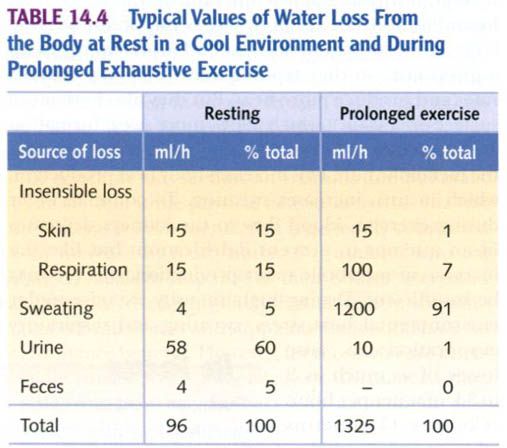Water balance at rest
Under normal resting conditions, the body’s
water content is relatively constant: water intake equals water output. About
60% of our daily water intake is obtained from the fluids we drink and about
30% is from the food we consume. The remaining 10% is produced in our cells
during metabolism. Metabolic water production varies from 150 to 250 ml per
day, depending on the rate of energy expenditure: higher metabolic rates
produce more water. The total daily water intake from all sources averages
about 33ml per kilogram of body weight per day. For a 70kg(154lb) person,
average intake is 2.3L per day. Water output, or water loss, occurs from
four sources:
- Evaporation from the skin;
- Evaporation from the
respiratory tract;
- Excretion from the kidneys;
- Excretion from the large
intestine.
Human skin is permeable to water. Water
diffuses to the skin’s surface, where it evaporates into the environment. In
addition, the gases we breathe are constantly being humidified by water as they
pass through the respiratory tract. These two types of water loss(from the skin
and respiration) occur without our sensing them. Thus, they are termed
insensible water losses. Under cool, resting conditions, these losses account
for about 30% of daily water loss.
The majority of our daily water loss – 60% at
rest – occurs from our kidneys, which excrete water and waste products as
urine. Under resting conditions, the kidneys excrete about 50 to 60ml of water
per hour. Another 5% of the water is lost by sweating(although this is often
considered along with insensible water loss), and the remaining 5% is excreted
from the large intestine in the feces. The sources of water gain and water loss
are presented in the picture below.
Water balance during exercise
Water loss accelerates during exercise, as seen
in the table below. The ability to lose the heat generated during exercise
depends primarily on the formation and evaporation of sweat. As body
temperature increases, sweating increases in an effort to prevent overheating.
But at the same time, more water is produced during exercise because of
increased oxidative metabolism. Unfortunately, the amount produced even during
the most intense effort has only a small impact on the dehydration, or water loss, that results from heavy sweating.
In general, the amount of sweat produced during
exercise is determined by:
·
Environmental temperature, radiant heat load,
humidity and air velocity;
·
Body size;
·
Metabolic rate.
These factors influence the body’s heat storage
and temperature. Heat is transferred from warmer areas to cooler ones, so heat
loss from the body is impaired by high environmental temperatures, radiation,
high humidity, and still air. Body size is important because large individuals
generally expend more energy to do a given task, so they typically have higher
metabolic rates and produce more heat. But they also have more surface
area(skin), which allows more sweat formation and evaporation. As exercise intensity increases, so does the metabolic
rate. This increases body heat production, which in turn increases sweating. To
conserve water during exercise, blood
flow to the kidneys decreases in an attempt to prevent dehydration; but like
the increase in metabolic water production, this too may be insufficient.
During high- intensity exercise under environmental heat stress, sweating and
respiratory evaporation can cause losses of as much as 2 to 3L of water per hour.
Dehydration and exercise performance
Even minimal changes in the body’s water
content can impair endurance performance. Without adequate fluid replacement,
an athlete’s exercise tolerance shows a pronounced decrease during long-term
activity because of water loss through sweating. The impact of dehydration on
the cardiovascular and thermoregulatory systems is quite
predictable. Fluid loss decreases plasma volume. This decreases blood pressure,
which in turn reduces blood flow to
the muscles and skin. In an effort to overcome this,heart rate increases. Because less blood reaches the skin, heat
dissipation is hindered, and the body retains more heat. Thus, when a person is
dehydrated by 2% of body weight or more, both heart rate and body temperature are elevated during exercise above
values observed when normally hydrated.
As one might expect, these physiological
changes will decrease exercise performance. Figure below illustrates the
effects of an approximate 2% decrease in body weight attributable to dehydration
from the use of a diuretic on distance runners’ performance in 1500m, 5000m,
and 10,000m time trials on outdoor track. The dehydration condition resulted in
plasma volume decreases between 10% and 12%. Although the average VO2max did not differ between
the normally hydrated and dehydrated trials, mean running velocity decreased by
3% in the 1500m run and by more than 6% in the 5000m and 10,000m runs. The
greater the duration of the performance, the greater is the expected decline in
performance for the same degree of dehydration. These trials were conducted in
relatively cool weather. The higher the temperature, humidity, and radiation,
the greater the expected decrement in performance for the same degree of
dehydration. The decrement in performance would be progressively greater with
greater levels of dehydration.
The effect of dehydration on performance in
muscular strength, muscular endurance, and anaerobic types of activities is not
as clear. Decrements have been seen in some studies, whereas other studies have
shown no change in performance. In one of the best-controlled studies,
researchers at Penn
State University
Wrestlers and other weight-category athletes
commonly dehydrate to get a weight advantage during the weigh-in for a
competition. Most rehydrate after the weigh-in before the competition and
experience only small decrements in performance.












0 коментара:
Постави коментар